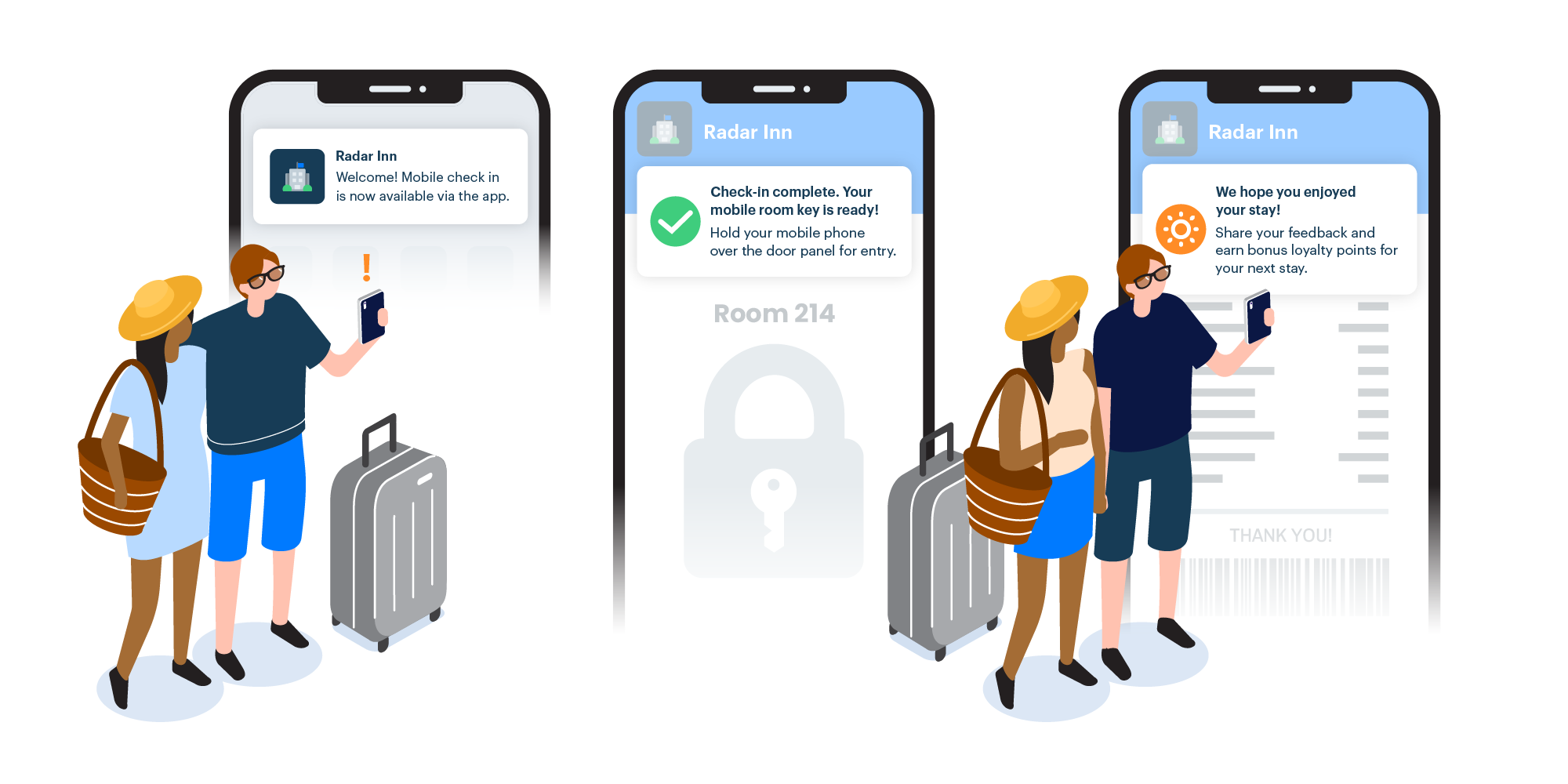Top geofencing strategies for hotel chains to improve guest experiences and cultivate loyalty
Hotels have long been in the business of exceeding guest expectations to beat competition, secure high ratings, and prompt repeat bookings. Mobile apps have become a foundational driver of the personalization guests expect post-COVID, and 91% of hotel executives surveyed by Oracle agree mobile technologies are critical to improving guest experience and cultivating loyalty.
Here are a few ways hotels can use geofencing to power exceptional experiences that keep guests coming back and spending more.

Improve convenience and safety with mobile room keys
The number of hotels offering digital room keys jumped from 6% to 17% from 2016-2018, and that percentage is only growing. Now that COVID has underscored the importance of safety measures, digital room keys are becoming a feature hotel guests expect. In response, Hilton is making their app a tool for guests to select their room from a map of the hotel they’re checking into, receive a key, and proceed with a contactless point of entry for the duration of their stay.
Geofencing can be used to drive feature adoption of the digital room key feature by surfacing the functionality within the app at pivotal moments: for instance, after initially checking into the hotel or when opening the app while approaching room quarters.
Reduce labor costs with on-property app features
Considering 76% of travelers say their mobile device is their most important travel companion, it’s time for hotels to leverage tech to alleviate their largest incurred cost, which is labor. The James Hotels released the James Pocket Assistant in 2014, which was designed to act as an e-concierge, allowing guests access to special offers, view maps, contact the hotel, and request services through the app.
By understanding when a guest is opening the app at a hotel site, Radar can power an on-premise app mode that prioritizes contactless concierge to serve as a parking attendant, take a room service order, or suggest a nearby restaurant or add on service. The app can replace anything that the front desk or a phone call could do more efficiently, driving labor savings.
Boost ancillary revenue with relevant recommendations
Hotels offer more than rooms and rates. The best way to maximize revenue from a stay is through additional services and products offered during the hotel experience. Marriott has used beacon technology to greet guests upon arrival and trigger push notifications with special offers as they travel around the property.
Radar has support for beacons as well as flexible, customizable polygon geofences, which can be used to geofence certain areas of the hotel property. Through integrations with leading customer engagement platforms, Radar can send guests location-based offers throughout their stay for nearby attractions, spa treatments, or room service to boost ancillary revenue. For example, hotels can use Radar to send a highly relevant message to guests on the property right before dinnertime for “free appetizers at the hotel restaurant.”
Speed up guest check-in with ETAs and arrival detection
Surveys indicate that guests become frustrated when they spend even 5 minutes at check-in. According to Criton, 62% of guests would be likely or very likely to check-in to a hotel via an app. There’s a big opportunity for hotels to leverage Radar’s trip tracking technology for arrival detection and ETAs to improve the check-in experience. Guests can be prompted to complete a mobile check-in when en-route to the hotel or notify the hotel so that staff can prepare room keys for guests before they arrive. In either case, staff is more prepared for guests arrival, wait times are reduced by 20%, and guests can experience convenience right off the bat with a welcome greeting on their device and expedited services.
Get real-time feedback to increase and measure customer satisfaction
Reviews have a big impact on future business, but they can be unpredictable. Using Radar, hotels can trigger events as guests move around the property. Hotels can use these location events to prompt for feedback in real-time after guests check in, visit the spa, or have a meal or drink at the hotel restaurant. By giving guests a platform to share any negative feedback within private in-house forums, hotels reduce the chance of a more public negative review later. With insight into any grievances as they occur, hoteliers can resolve the situation to convert a displeased guest into a loyal customer.
Promote loyalty adoption
Hotels are investing in great experiences to drive loyalty. The Marriott Bonvoy app is a great example of a loyalty app offering personalized and contactless experiences, with tailored promotions, a mobile key, and more.
Radar’s geofencing and arrival detection enables hotels to surface important app features at the right time, and enables location-based segmentation of loyalty rewards members to send special offer messages before, during, and after a stay. Moreover, hotels can use Radar to communicate the value of loyalty rewards at critical moments. For example, guests can be prompted to share feedback and in exchange for loyalty points for their next visit.
Frictionless experiences raise chances that guests will come back and spend more with a hotel brand. Location is the input that can help hotels remove friction by positioning the app as a helpful tool for guests’ needs at the right place and time.
Through Radar’s leading geofencing platform, it has never been easier for hotels to enable location-based experiences.
If you’re interested in leveraging geofencing to exceed guest expectations and prompt repeat bookings, we’d love to hear from you.